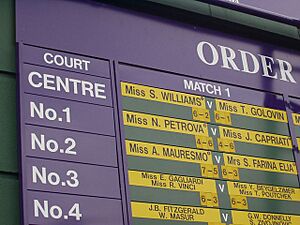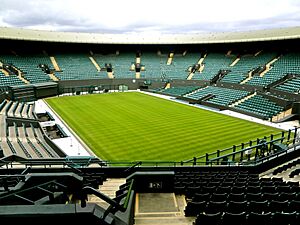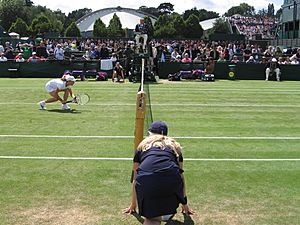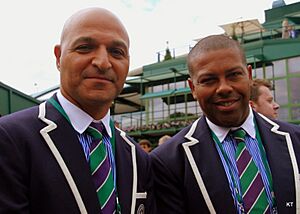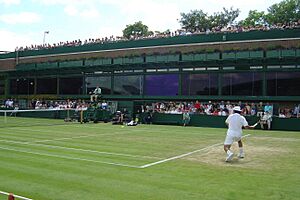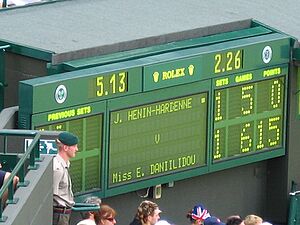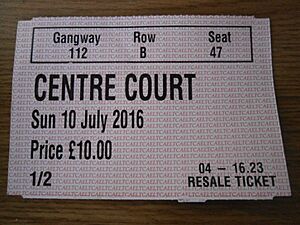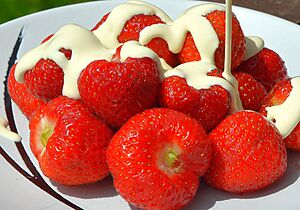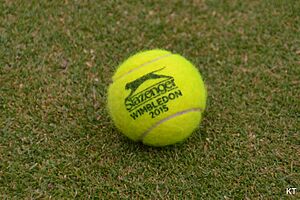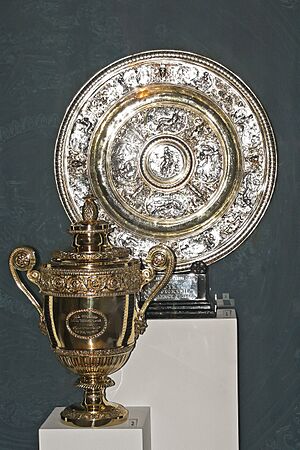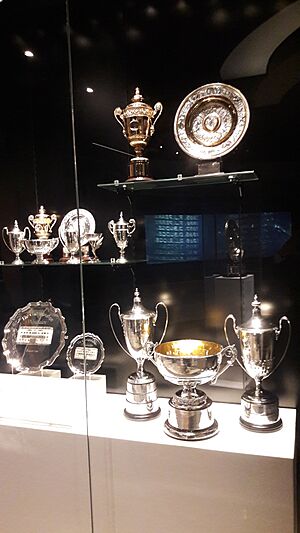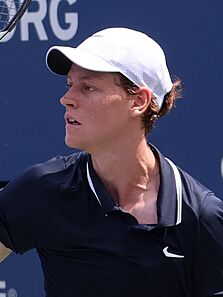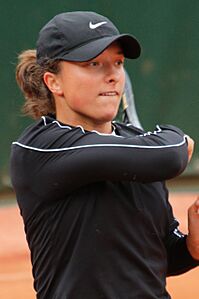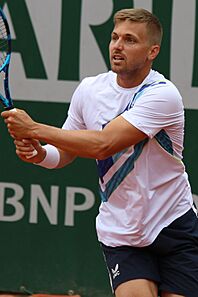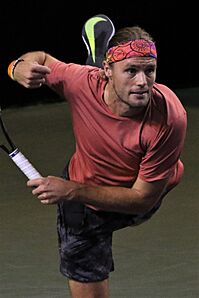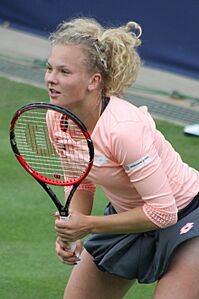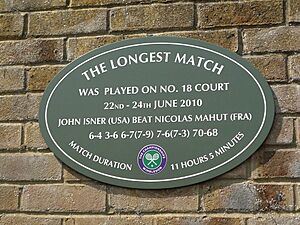Wimbledon Championships facts for kids
 |
|
| Official website: https://www.wimbledon.com | |
| Founded | 1877 |
|---|---|
| Editions | 138 (2025) |
| Location | Wimbledon, London England |
| Venue | All England Lawn Tennis and Croquet Club Worple Road (1877–1921) Church Road (since 1922) |
| Surface | Grass outdoors |
| Prize money | £53,550,000 (2025) |
| Men's | |
| Draw | S (128Q) / 64D (16Q) |
| Current champions | Jannik Sinner (singles) Julian Cash Lloyd Glasspool (doubles) |
| Most singles titles | Roger Federer (8) |
| Most doubles titles | Todd Woodbridge (9) |
| Women's | |
| Draw | S (128Q) / 64D (16Q) |
| Current champions | Iga Świątek (singles) Veronika Kudermetova Elise Mertens (doubles) |
| Most singles titles | Martina Navratilova (9) |
| Most doubles titles | Elizabeth Ryan (12) |
| Mixed doubles | |
| Draw | 32 |
| Current champions | Sem Verbeek Kateřina Siniaková |
| Most titles (male) | Leander Paes (4) Vic Seixas (4) Owen Davidson (4) Ken Fletcher (4) |
| Most titles (female) | Elizabeth Ryan (7) |
| Grand Slam | |
|
|
| Last completed | |
| 2025 Wimbledon | |
The Wimbledon Championships, often just called Wimbledon, is a famous tennis tournament. It is held every year in Wimbledon, London, England. This event is organized by the All England Lawn Tennis and Croquet Club with the Lawn Tennis Association.
Wimbledon is one of the four biggest tennis events each year, known as Grand Slams. It happens after the Australian Open and the French Open, and before the US Open. It is the oldest tennis tournament in the world. Many people think it is the most important one.
The tournament has been held since 1877. It is played on outdoor grass courts. Wimbledon is the only major tennis event still played on grass. This is the traditional surface for tennis. It also has a special rule: matches must stop by 11:00 PM BST. This is to avoid late-night noise for people living nearby. Since 2009, matches can continue under floodlights until the curfew.
Wimbledon usually takes place over two weeks. It starts in late June or early July. The Ladies' and Gentlemen's Singles Finals are played on the last Saturday and Sunday. There are five main events each year. There are also competitions for junior players and special invitation events. In 2009, the main court, Centre Court, got a retractable roof. This helps stop play from being lost due to rain. No. 1 Court also got a roof in 2019. Many other improvements were made then, like comfy seats and a player warm-up area.
Wimbledon has many special traditions. Players must wear all-white clothes. The tournament also has royal support. Eating strawberries and cream is a popular tradition. In recent years, people also enjoy champagne with it. Unlike other tournaments, there is not much advertising. Official partners like Slazenger and Rolex keep their ads small. Slazenger has provided tennis balls since 1902. This is the longest sports sponsorship in the world.
Due to the COVID-19 pandemic, the 2020 Wimbledon tournament was cancelled. This was the first time it was cancelled since World War II. The 134th tournament was held from June 28 to July 11, 2021. The 135th edition was played from June 27 to July 10, 2022. For the first time, matches were regularly played on the middle Sunday. This marked 100 years since the first championships at Centre Court. In 2022, the ATP, ITF, and WTA did not give ranking points for the tournament. This was because Wimbledon did not allow players from Russia and Belarus to compete.
The 2025 Wimbledon Championships ran from June 30 to July 13. For the first time in its 147-year history, all human line judges were replaced. Electronic line calling systems were used instead. This event also saw a big British win. Julian Cash and Lloyd Glasspool became the first all-British men's doubles champions since 1936.
Contents
History of Wimbledon
How it All Started
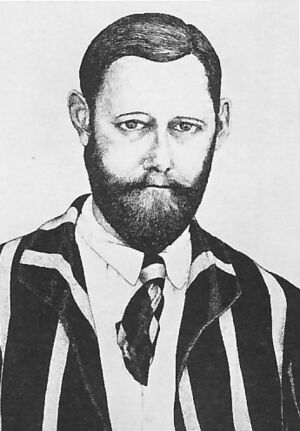
The All England Lawn Tennis and Croquet Club started on July 23, 1868. It was first called "The All England Croquet Club." Its first playing field was on Nursery Road in Wimbledon.
In 1876, lawn tennis was added to the club's activities. This game was created by Major Walter Clopton Wingfield. It was an outdoor version of an older game called real tennis. In spring 1877, the club changed its name to "The All England Croquet and Lawn Tennis Club." To show this change, they held the first Lawn Tennis Championship. New rules were made for the event. Today's rules are very similar.
The first 1877 Wimbledon Championship began on July 9, 1877. Only the Gentlemen's Singles event was held. Twenty-two men paid a fee to enter. The tournament was supposed to last five days. But rain delayed it for four more days. So, the final was played on July 19, 1877. Spencer Gore won the match. He beat William Marshall in 48 minutes. Gore received a silver cup and prize money. About 200 people watched the final.
The main court at the first location was in the middle of the other courts. This is why it was called "Centre Court." The name stayed when the club moved in 1922. Even though it was no longer exactly in the center, the name remained.
By 1882, the club mostly focused on lawn tennis. So, the word "croquet" was removed from its name. But it was added back in 1899 for old times' sake.
In 1884, the club added the Ladies' Singles competition. The Gentlemen's Doubles event also moved to Wimbledon that year. Ladies' doubles and mixed doubles events were added in 1913. The first black player to compete at Wimbledon was Bertrand Milbourne Clark from Jamaica in 1924.
Until 1922, the champion from the previous year only had to play in the final match. They would play against whoever won all the earlier rounds. Wimbledon used to be only for amateur players. Professional players were not allowed. This changed in 1968 with the start of the Open Era. No British man won the singles event between Fred Perry in 1936 and Andy Murray in 2013. No British woman has won since Virginia Wade in 1977. However, Annabel Croft and Laura Robson won the Girls' Championship in 1984 and 2008. The Championship was first shown on TV in 1937.
The tournament was not held from 1915 to 1918 because of World War I. It was also not held from 1940 to 1945 during World War II. In 1940, a bomb hit a part of Centre Court. The championships still went ahead in 1946. But 1,200 seats were lost due to the damage. The court was fully repaired by 1949.
Wimbledon in the 21st Century
Wimbledon is seen as the best tennis tournament in the world. The club always tries to keep it that way. In 1993, a long-term plan was started. It aimed to make the event better for everyone. The first part of the plan finished in 1997. It included building the new No. 1 Court and a broadcast center.
The second part of the plan finished in 2009. It involved building the Millennium Building. This building has many facilities for players, press, and club members. The West Stand of Centre Court also got more seats. The third part of the plan finished in 2011. It added a new entrance, a museum, and a ticket office.
A new retractable roof was ready for the 2009 championships. This meant rain would not stop play on Centre Court for long periods. The club tested the roof with special matches in May 2009. The first match played entirely under the new roof was between Andy Murray and Stanislas Wawrinka on June 29, 2009. Murray also played in the latest finishing match at Wimbledon. It ended at 11:02 PM in 2012. The 2012 Gentlemen's Singles Final was the first final partly played under the roof.
A new 4,000-seat No. 2 Court was built for the 2009 Championships. A new 2,000-seat No. 3 Court was also built.
In 2012, the All England Club hosted the tennis events for the Summer Olympic Games. It was the first Olympic grass court tournament since tennis became an Olympic sport again.
In 2013, Wimbledon shared its 'Master Plan'. This plan aimed to improve the championships over the next 10 to 15 years. It included new facilities for players and media. It also planned to expand No. 1 Court with a new roof. The plan also involved buying land from the nearby Wimbledon Park Golf club. This would allow qualifying matches to be played on site.
On October 19, 2018, a new rule was announced. A tie-break would be played if the score reached 12-12 in the final set of any match. This applies to all competitions. Also, quad wheelchair competitions became a permanent event starting in 2019.
Because of the COVID-19 global pandemic, the All England Club cancelled the 2020 tournament. This was announced on April 1, 2020. It was the first time Wimbledon was not played since World War II. Club officials thought about holding the tournament without fans. But they decided against it. Many people, like ball boys and security, would still need to be there. The club had insurance for cancellation due to a pandemic.
In April 2022, the All England Club decided to not allow Russian and Belarusian players to compete. This was due to the 2022 Russian invasion of Ukraine. The ATP, ITF, and WTA then announced they would not give ranking points for the tournament. They felt the ban was unfair. On March 31, 2023, the ban on Russian and Belarusian players was lifted.
On October 9, 2024, it was announced that electronic line calling technology would replace human line judges. This change started with the 2025 tournament. This ended 147 years of traditional line judges at Wimbledon. Now, only the chair umpire is on the court. New "match assistants" help players with things like bathroom breaks.
Wimbledon Events
Wimbledon has five main events. It also has four junior events and seven invitation events.
Main Events
The five main events and the number of players or teams are:
- Gentlemen's Singles (128 players)
- Ladies' Singles (128 players)
- Gentlemen's Doubles (64 teams)
- Ladies' Doubles (64 teams)
- Mixed Doubles (32 teams)
Junior Events
The four junior events and the number of players or teams are:
- Boys' Singles (64 players)
- Girls' Singles (64 players)
- Boys' Doubles (32 teams)
- Girls' Doubles (32 teams)
There is no mixed doubles event for junior players.
Invitation Events
The seven invitation events and the number of pairs are:
- Gentlemen's Invitation Doubles (8 pairs, Round Robin)
- Ladies' Invitation Doubles (8 pairs, Round Robin)
- Senior Gentlemen's Invitation Doubles (8 pairs, Round Robin)
- Gentlemen's Wheelchair Singles
- Ladies' Wheelchair Singles
- Gentlemen's Wheelchair Doubles (4 pairs)
- Ladies' Wheelchair Doubles (4 pairs)
Match Rules
Matches in the Gentlemen's Singles are best-of-five sets. This means a player needs to win three sets to win the match. In 2023, Gentlemen's Doubles matches changed to best-of-three sets. All other events are also best-of-three sets.
Before 2019, a tiebreak game was played if the score reached 6-all in any set, except the final set. In the final set, a player needed to win by two games. Since 2019, a final set tiebreak game is played if the score in the final set reaches 12-all. In 2022, it was decided that all matches would have a final set tiebreak at 6-6. This is a "champions tiebreak," where the winner needs to get to 10 points and win by two points. If the score is 9-9, play continues until one player wins by two points.
All events are single-elimination tournaments. This means if you lose one match, you are out. The only exceptions are the Invitation Doubles events, which are round-robin tournaments. In these, teams play against everyone else in their group.
Before 1922, the winners from the previous year got a special advantage. They only had to play in the final match. This helped many champions keep their titles. But since 1922, all players, including champions, must play all rounds.
Wimbledon Schedule
Each year, the tournament starts on the last Monday in June or the first Monday in July. This is two weeks after the Queen's Club Championships. That event is a major warm-up tournament for men. Other grass-court tournaments happen before Wimbledon too.
Since 2015, Wimbledon has started one week later than before. This gives players more time between the French Open and Wimbledon.
Wimbledon lasts for 14 days. It begins on a Monday and ends on a Sunday. The five main events happen over both weeks. Junior and invitation events are mostly held during the second week.
Traditionally, there was no play on the "Middle Sunday." This was a rest day. However, rain forced play on Middle Sunday four times in the past. In 2022, regular play began on Middle Sunday for the first time. This was because of better grass technology.
Before 2022, the second Monday was called "Manic Monday." This was the busiest day. All the last-16 matches for both men's and women's singles were played. Fans could watch any of the best 32 players on one day.
Wimbledon is now the only Grand Slam that still starts on a Monday.
Curfew Rules
Wimbledon has a special rule called a curfew. All matches must finish before 11:00 PM. This rule started in 2009. It is in place to protect local residents from late-night noise. When the roof was built on Centre Court, the local council set this time limit. This was part of the permission to build the roof.
A statement from Wimbledon in 2018 explained it. The 11 PM curfew balances the needs of local residents with a big international event. Getting visitors home safely is also important.
Players and Seeding
Both the men's and ladies' singles events have 128 players. Most players get into the main events based on their international rankings. There are 104 direct entries for men and 108 for ladies. Both tournaments also have 8 wild card players. These are special invitations. The rest of the spots are filled by players who win qualifying matches.
Since 2001, 32 players in the singles events are "seeded." This means they are ranked and placed in the draw to avoid playing top players early. There are 16 seeded teams in the doubles events. Seeding started in 1924.
The Committee of Management decides which players get wild cards. Wild cards are usually given to players who have done well before. Or they might be players who would make Wimbledon more exciting to watch. Only one wild card player has won the Gentlemen's Singles Championship. That was Goran Ivanišević in 2001.
Players who are not ranked high enough and do not get wild cards can play in a qualifying tournament. This happens one week before Wimbledon. It takes place at the Bank of England Sports Ground. The singles qualifying events have three rounds. Since 2019, singles qualification has 128 players. There is no qualifying tournament for Mixed Doubles. The furthest a qualifier has reached in a Singles tournament is the semi-final round.
Players get into junior tournaments based on their national tennis associations' recommendations. Their international rankings also play a part. The Committee of Management decides who can enter the invitation events.
The Committee seeds the top players based on their rankings. But they can change the seedings based on how well a player has done on grass courts before. Since 2021, the seeding for Gentlemen's Singles follows the same process as the ATP rankings.
Most players in the tournament are not seeded. Only two unseeded men have won the Gentlemen's Singles. They were Boris Becker in 1985 and Goran Ivanišević in 2001. In 1985, Becker was ranked 20th. Ivanišević was ranked 125th when he won as a Wild Card. He had been a finalist three times before. His low ranking was due to a long-term shoulder injury. In 2023, Marketa Vondrousova became the first unseeded woman to win the Ladies' Singles title. She was ranked 42nd in the world. Unseeded teams have won the doubles titles many times.
Wimbledon Grounds
Since 2001, the courts at Wimbledon have been planted with 100% perennial ryegrass. This change was made to make the courts stronger and last longer. This helps them handle the intense play of modern tennis.
The main courts, Centre Court and No. 1 Court, are usually used for only two weeks a year. This is during the Championships. The other 17 courts are used regularly for other club events. In 2012, the main courts were used again for the tennis events of the 2012 Olympic Games.
Wimbledon is the only remaining Grand Slam event played on natural grass courts. In the past, most major tournaments were played on grass. But the US Open changed to clay in 1975, and then to hard courts. The Australian Open also changed to hard courts in 1988.
From 1877 to 1921, the club's grounds were in central Wimbledon. In 1908, this place hosted the tennis events for the 1908 Summer Olympic Games. As more people came to the Championships, the club needed a bigger space. So, they moved to a new home in 1922. The new Centre Court was much larger.
Because it can rain during Wimbledon, a retractable roof was added to Centre Court in 2009. It can close or open in 20 minutes. This roof is mainly used to protect play from bad weather. When the roof is opening or closing, play stops. The first time the roof was closed during a Wimbledon match was on June 29, 2009.
Centre Court can hold 14,979 people. At its south end is the Royal Box. Members of the Royal Family and other important guests watch matches from there. Centre Court usually hosts the finals and semifinals. It also hosts many early matches with top players.
The second most important court is No. 1 Court. It was built in 1997. The old No. 1 Court was too small. Many players loved the old No. 1 Court because it felt more personal. A new retractable roof was built on No. 1 Court after the 2017 Championships. It was ready for the 2019 championships. The stadium's capacity also increased to 12,345 seats.
Since 2009, a new No. 2 Court has been used. It can hold 4,000 people. The old No. 2 Court was known as the "Graveyard of Champions." This is because many top players lost there in early rounds. These included Ilie Năstase, John McEnroe, and Serena Williams. The old No. 2 Court is now called No. 3 Court.
Wimbledon hires 'Court Attendants' each year. They help keep the courts in good condition. Their main job is to quickly cover the courts when it rains. This helps play start again fast. Most outer court attendants are university students. Full-time staff cover Centre Court.
At the north end of the grounds, there is a giant TV screen. Important matches are shown there for fans without court tickets. Fans watch from a grassy area called the Aorangi Terrace. When British players do well, this area gets very popular. It is sometimes called "Henman Hill" or "Murray Mound" by the press. These are not official names.
Qualifying Matches Location
The qualifying matches happen at the Bank of England Sports Ground. This is about 3.6 miles (5.8 km) from the All England Club.
Wimbledon Traditions
Wimbledon has many unique traditions.
Ball Boys and Ball Girls
In the championship games, ball boys and girls are called BBGs. A good BBG should not be noticed. They should do their jobs quietly in the background.
Since 1969, BBGs have come from local schools. They are usually around 15 years old. They can serve for one tournament, or up to five if they are chosen again.
BBGs work in teams of six. Two are at the net, and four are at the corners. Teams rotate, working one hour on court and one hour off. They are not told which court they will work on each day. This ensures high standards on all courts. About 250 BBGs are needed. They get a certificate, used balls, a photo, and a program. BBGs are paid for their service. Girls have been included since 1977. They first appeared on Centre Court in 1985.
To become a BBG, students are nominated by their school. They must pass written tests on tennis rules. They also pass fitness and other tests. Successful candidates then train weekly starting in February. This training makes sure BBGs are fast, alert, and confident.
Umpires
At Wimbledon, many chair umpires are assigned each day. They usually work two matches. They use tablet computers to score matches. These scores are shown on scoreboards and online.
Before 2025, line umpires worked in teams. In 2007, a new technology called Hawk-Eye was introduced. This technology shows if the ball landed in or out. Wimbledon used Hawk-Eye but also kept line umpires. Players could ask to see the Hawk-Eye replay three times per set.
Starting from the 2025 Championships, human line umpires were replaced. This was due to professional tennis tours using Hawk-Eye Live technology. Now, the only umpire on the court is the chair umpire.
Colours and Uniforms
Dark green and purple are the traditional Wimbledon colours. However, all tennis players must wear all-white clothing. This has been a long-time tradition at Wimbledon since 1963. Small coloured trims are allowed, but they must not be wider than 1 cm. All other clothing items, like shorts and socks, must be mostly white.
In 2023, a new rule allowed female players to wear non-white underwear. This means they can wear solid, dark-coloured undershorts. These undershorts must not be longer than their shorts or skirt.
Before 2006, chair umpires, linesmen, and ball boys and girls wore green. Since 2006, officials and BBGs wear new navy blue and cream uniforms. These are designed by Ralph Lauren.
Referring to Players
By tradition, the men's and women's competitions are called "Gentlemen's" and "Ladies'" at Wimbledon. Junior competitions are called "Boys'" and "Girls'."
Before 2009, female players were called "Miss" or "Mrs" on scoreboards. On the Champions Board, married female players were listed by their husband's name until 2019. Since 2009, players are called by both their first and last names on scoreboards.
The title "Mr" is not used for professional male players on scoreboards. But it is used for amateurs. Chair umpires say "Mr [surname]" when a player challenges a call. Until 2018, chair umpires said "Miss"/"Mrs [surname]" when announcing scores for ladies' matches. This changed in 2019. As of 2022, the use of Mr, Miss, and Mrs was removed. Players are now called by their names, as shown on the scoreboard.
If two players have the same last name, the umpire will say their first name too. For example, "Game, Venus Williams."
Royal Family
In the past, players bowed or curtsied to members of the royal family in the Royal Box. This happened when they entered or left Centre Court. But in 2003, this tradition was mostly stopped. Now, players only need to bow or curtsy if the Prince of Wales or the King is present. This happened in 2010 when Elizabeth II was there.
On June 27, 2012, Roger Federer said he and his opponent were asked to bow. This was because Prince Charles and his wife were present. Federer said it was not a problem for him.
Services Stewards
Before World War II, soldiers and retired military members were stewards. Since 1946, the club has offered jobs to servicemen returning from the war. Members of the London Fire Brigade also joined in 1965. These service stewards wear uniforms. They work on Centre Court and other main courts. Only active members of the Armed Forces can apply for this role. They must take it as leave. The club pays them a small amount to help with their living costs.
Tickets
Most tickets for Centre and show courts are sold through a public ballot. The All England Club holds this ballot at the start of each year. Many more people apply than there are tickets. Successful applicants are chosen randomly by a computer. Applications must be sent by the end of December the year before the tournament. Tickets are not transferable.
The All England Club also sells special "debentures" every five years. This helps raise money for improvements. Fans who buy these debentures get a pair of tickets for every day of Wimbledon for five years. Only debenture holders can sell their tickets to others.
Wimbledon and the French Open are the only Grand Slams where fans can queue up on the day to get tickets. This is even if they don't have tickets already. Numbered queue cards were started in 2003. Since 2008, there is one queue. About 500 seats are given for each court. Many fans queue overnight. This is a big part of the Wimbledon experience. The club provides toilets and water for campers. Early in the morning, stewards give out wristbands for specific courts. These are exchanged for tickets at the ticket office. General admission to the grounds gives access to the outer courts. This does not require overnight queuing. Tickets returned by people leaving early are sold at 2:30 PM. The money goes to charity. Queuing for show courts stops after the quarter-finals.
On Day Seven of the 2010 Championships, the one-millionth Wimbledon queue card was given out.
Sponsorship
Unlike other tournaments, advertising at Wimbledon is very minimal. It comes from official suppliers like IBM, Rolex, and Slazenger. Wimbledon has the longest-running sports sponsorship. Slazenger has supplied all tennis balls since 1902. From 1935 to 2021, Wimbledon also had a sponsorship deal with Robinsons fruit squash.
Starting in 2024, Emirates began sponsoring Wimbledon. They also sponsor the other Grand Slam tournaments.
Strawberries and Cream
Strawberries and cream are a traditional food for spectators at Wimbledon. They are a big part of the tournament's culture. This tradition might have started with King Henry VIII. He is said to have eaten wild strawberries and cream at Hampton Court, near Wimbledon. Since the King enjoyed it, the dessert became popular. In 2017, fans ate 34,000 kg of British strawberries and 10,000 liters of cream. In 2019, over 190,000 portions were served.
The Wimbledon Champions' Dinner and Ball
The Wimbledon Champions' Dinner is held after the tournament ends. It used to be called the Champions' Ball. It includes a dinner and a dance for the Men's and Women's singles winners. They also take a picture with their trophies.
In recent years, the dance part became optional. But it has returned sometimes. For example, in 2015, Novak Djokovic and Serena Williams danced together. In 2018, Djokovic invited Angelique Kerber to dance. In 2024, the champions Carlos Alcaraz and Barbora Krejčíková also danced together.
In 1977, the dinner was moved to the middle Saturday. This led to the end of the regular champions' dance.
The Champions' Dinner is now held at The Lawn. This is a special place on the grounds of The Wimbledon Club. Players, their families, and special guests gather to celebrate the champions.
In 2021, the Champions' Dinner was cancelled due to COVID-19 rules. This was a rare break in the tradition.
Tennis Balls
Since 1902, Wimbledon has used tennis balls made by Slazenger. The company has been the official supplier ever since. This is the longest-running sponsorship deal in sports.
Media Coverage and Attendance
Radio Wimbledon
Radio Wimbledon used to be heard within a five-mile area on 87.7 FM. It was also available online. It stopped in 2011. Presenters and reporters would share news and commentary. They often reported from the "Crow's Nest." This is a high building with views of most outside courts. Radio Wimbledon's theme song is "Purple and Green." It has been used since 1996.
Television Coverage
United Kingdom
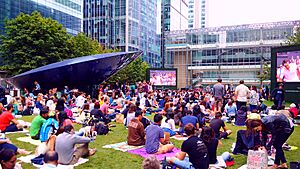
Since 1937, the BBC has shown Wimbledon on TV in the United Kingdom. Since 1969, the BBC has been the only broadcaster. Matches are shown on BBC One and BBC Two, and their Red Button service. The BBC has the rights to broadcast Wimbledon until 2027.
The Wimbledon Finals must be shown live and in full on regular TV channels. Highlights of the rest of the tournament must also be provided.
In 2011, the BBC apologized because some viewers complained about too much talking by commentators. They said that views on commentary are different for everyone. But they understood that too much talking can be annoying.
Wimbledon was part of TV history on July 1, 1967. The first official colour television broadcast in the UK happened then. Four hours of live coverage of the 1967 Championships were shown on BBC Two. This was the first TV channel in Europe to regularly broadcast in colour. The tennis balls used to be white. But they were changed to yellow in 1986 to show up better on colour TV. Since 2007, Wimbledon matches have been shown in high-definition. Since 2018, all Centre Court matches are shown in 4K ultra-high-definition.
The BBC's opening music for Wimbledon since 1972 is called "Light and Tuneful." It was composed by Keith Mansfield. "A Sporting Occasion" is the traditional closing music.
Ireland
In Ireland, RTÉ broadcast Wimbledon in the 1980s and 1990s. They stopped in 1998 due to fewer viewers. From 2005 to 2014, TG4, Ireland's Irish-language broadcaster, showed the tournament. Live coverage was in Irish.
Since 2015, Wimbledon has been on pay TV in Ireland. First on Setanta Sports, then Eir Sport.
Americas
In the United States, ABC started showing highlights of the Wimbledon Gentlemen's Singles Final in the 1960s. NBC began covering Wimbledon in 1969. They showed taped coverage of the Gentlemen's Singles Final. In 1979, they started showing it live. In 1982, they added the Ladies' Singles Final. For many years, NBC aired "Breakfast at Wimbledon" specials on weekends. Live coverage started early in the morning.
From 1975 to 1999, HBO showed weekday coverage. ESPN became the cable TV partner in 2003.
The All England Club was not happy with NBC's schedule. NBC often delayed showing quarterfinal and semifinal matches. Starting with the 2012 tournament, coverage moved to ESPN and ESPN2. This made Wimbledon an event shown only on pay television in the US. ESPN Deportes provides coverage in Spanish. The Finals are also shown later on ABC. In 2021, ESPN and the All England Club agreed to extend ESPN's coverage until 2035. This included live coverage on ABC starting in 2022.
Taped coverage is also shown on Tennis Channel. It is called Wimbledon Primetime.
In Canada, TSN and RDS show Wimbledon. Before 2012, CBC Television was the main broadcaster.
In Mexico, the Televisa networks have shown Wimbledon since the 1960s. Most weekend matches are on Canal 5. Weekday matches are on the Televisa Deportes Network.
In most of Latin America, Wimbledon is shown on ESPN. In Brazil, SporTV has the rights.
Other Countries
In several European countries, Wimbledon is shown live on Eurosport 1, Eurosport 2, and the Eurosport Player. There are some exceptions, like in Denmark and Italy. In Germany, Wimbledon has been on Sky Sport since 2007.
In Australia, the Nine Network covered Wimbledon for almost 40 years. Then the Seven Network broadcast it from 2011. Fox Sports Australia also covered the event. Free-to-air coverage returned to Nine Network in 2021. In India, it is on Star Sports. In Pakistan, it is on PTV Sports.
In New Zealand, coverage is free-to-air on TVNZ One. Their channel TVNZ Duke also shows other matches.
Most matches can also be watched online through live streaming services. Cameras are set up on almost all courts.
Trophies, Prize Money, and Ranking Points
Trophies
The Gentlemen's Singles champion receives a silver-gilt cup. It is about 18.5 inches (47 cm) tall. The trophy has many symbols, including a small gold pineapple. This trophy has been given out since 1887. The actual trophy stays at the All England Club museum. The champion gets a smaller copy of the cup.
The Ladies' Singles champion receives a silver plate. It is known as the "Venus Rosewater Dish." The dish is about 18.75 inches (48 cm) wide. It is decorated with figures from old stories. The actual dish also stays at the museum. The champion receives a smaller copy.
Winners of the Gentlemen's Doubles, Ladies' Doubles, and Mixed Doubles events receive silver cups. Each player in a doubles team gets a trophy. This is different from other Grand Slam tournaments. The Gentlemen's Doubles cup was given to the club in 1884. The Ladies' Doubles Trophy was given in 1949. The Mixed Doubles Trophy was given by the family of a past winner.
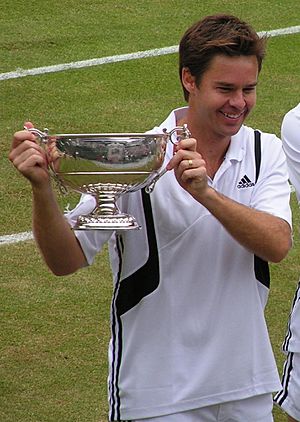
The runner-up in each event receives an engraved silver plate. The trophies are usually given out by the Patron of the All England Club, The Princess of Wales.
Prize Money
Prize money was first given out in 1968. This was the first year professional players could compete. The total prize money was £26,150. The men's singles winner received £2,000. The women's singles champion received £750. In 2007, Wimbledon and the French Open became the last Grand Slam tournaments to give equal prize money to women and men.
| Year | Gentlemen's singles | Gentlemen's doubles (pair) | Ladies' singles | Ladies' doubles (pair) | Mixed doubles (pair) | Total for tournament |
|---|---|---|---|---|---|---|
| 1968 | £2,000 | £800 | £750 | £500 | £450 | £26,150 |
| 1969 | £3,000 | £1,000 | £1,500 | £600 | £500 | £33,370 |
| 1970 | £3,000 | £1,000 | £1,500 | £600 | £500 | £41,650 |
| 1971 | £3,750 | £750 | £1,800 | £450 | £375 | £37,790 |
| 1972 | £5,000 | £1,000 | £3,000 | £600 | £500 | £50,330 |
| 1973 | £5,000 | £1,000 | £3,000 | £600 | £500 | £52,400 |
| 1974 | £10,000 | £2,000 | £7,000 | £1,200 | £1,000 | £97,100 |
| 1975 | £10,000 | £2,000 | £7,000 | £1,200 | £1,000 | £114,875 |
| 1976 | £12,500 | £3,000 | £10,000 | £2,400 | £2,000 | £157,740 |
| 1977 | £15,000 | £6,000 | £13,500 | £5,200 | £3,000 | £222,540 |
| 1978 | £19,000 | £7,500 | £17,100 | £6,500 | £4,000 | £279,023 |
| 1979 | £20,000 | £8,000 | £18,000 | £6,930 | £4,200 | £277,066 |
| 1980 | £20,000 | £8,400 | £18,000 | £7,276 | £4,420 | £293,464 |
| 1981 | £21,600 | £9,070 | £19,400 | £7,854 | £4,770 | £322,136 |
| 1982 | £41,667 | £16,666 | £37,500 | £14,450 | £6,750 | £593,366 |
| 1983 | £66,600 | £26,628 | £60,000 | £23,100 | £12,000 | £978,211 |
| 1984 | £100,000 | £40,000 | £90,000 | £34,700 | £18,000 | £1,461,896 |
| 1985 | £130,000 | £47,500 | £117,000 | £41,100 | £23,400 | £1,934,760 |
| 1986 | £140,000 | £48,500 | £126,000 | £42,060 | £25,200 | £2,119,780 |
| 1987 | £155,000 | £53,730 | £139,500 | £46,500 | £27,900 | £2,470,020 |
| 1988 | £165,000 | £57,200 | £148,500 | £49,500 | £29,700 | £2,612,126 |
| 1989 | £190,000 | £65,870 | £171,000 | £56,970 | £34,200 | £3,133,749 |
| 1990 | £230,000 | £94,230 | £207,000 | £81,510 | £40,000 | £3,819,730 |
| 1991 | £240,000 | £98,330 | £216,000 | £85,060 | £41,720 | £4,010,970 |
| 1992 | £265,000 | £108,570 | £240,000 | £93,920 | £46,070 | £4,416,820 |
| 1993 | £305,000 | £124,960 | £275,000 | £108,100 | £53,020 | £5,048,450 |
| 1994 | £345,000 | £141,350 | £310,000 | £122,200 | £60,000 | £5,682,170 |
| 1995 | £365,000 | £149,540 | £328,000 | £129,300 | £63,500 | £6,025,550 |
| 1996 | £392,500 | £160,810 | £353,000 | £139,040 | £68,280 | £6,465,910 |
| 1997 | £415,000 | £170,030 | £373,500 | £147,010 | £72,200 | £6,884,952 |
| 1998 | £435,000 | £178,220 | £391,500 | £154,160 | £75,700 | £7,207,590 |
| 1999 | £455,000 | £186,420 | £409,500 | £167,770 | £79,180 | £7,595,330 |
| 2000 | £477,500 | £195,630 | £430,000 | £176,070 | £83,100 | £8,056,480 |
| 2001 | £500,000 | £205,000 | £462,500 | £189,620 | £87,000 | £8,525,280 |
| 2002 | £525,000 | £210,000 | £486,000 | £194,250 | £88,500 | £8,825,320 |
| 2003 | £575,000 | £210,000 | £535,000 | £194,250 | £88,500 | £9,373,990 |
| 2004 | £602,500 | £215,000 | £560,500 | £200,000 | £90,000 | £9,707,280 |
| 2005 | £630,000 | £218,500 | £600,000 | £203,250 | £90,000 | £10,085,510 |
| 2006 | £655,000 | £220,690 | £625,000 | £205,280 | £90,000 | £10,378,710 |
| 2007 | £700,000 | £222,900 | £700,000 | £222,900 | £90,000 | £11,282,710 |
| 2008 | £750,000 | £230,000 | £750,000 | £230,000 | £92,000 | £11,812,000 |
| 2009 | £850,000 | £230,000 | £850,000 | £230,000 | £92,000 | £12,550,000 |
| 2010 | £1,000,000 | £240,000 | £1,000,000 | £240,000 | £92,000 | £13,725,000 |
| 2011 | £1,100,000 | £250,000 | £1,100,000 | £250,000 | £92,000 | £14,600,000 |
| 2012 | £1,150,000 | £260,000 | £1,150,000 | £260,000 | £92,000 | £16,060,000 |
| 2013 | £1,600,000 | £300,000 | £1,600,000 | £300,000 | £92,000 | £22,560,000 |
| 2014 | £1,760,000 | £325,000 | £1,760,000 | £325,000 | £96,000 | £25,000,000 |
| 2015 | £1,880,000 | £340,000 | £1,880,000 | £340,000 | £100,000 | £26,750,000 |
| 2016 | £2,000,000 | £350,000 | £2,000,000 | £350,000 | £100,000 | £28,100,000 |
| 2017 | £2,200,000 | £400,000 | £2,200,000 | £400,000 | £100,000 | £31,600,000 |
| 2018 | £2,250,000 | £450,000 | £2,250,000 | £450,000 | £110,000 | £34,000,000 |
| 2019 | £2,350,000 | £540,000 | £2,350,000 | £540,000 | £116,000 | £38,000,000 |
| 2021 | £1,700,000 | £480,000 | £1,700,000 | £480,000 | £100,000 | £35,016,000 |
| 2022 | £2,000,000 | £540,000 | £2,000,000 | £540,000 | £124,000 | £40,350,000 |
| 2023 | £2,350,000 | £600,000 | £2,350,000 | £600,000 | £128,000 | £44,700,000 |
| 2024 | £2,700,000 | £650,000 | £2,700,000 | £650,000 | £130,000 | £50,000,000 |
| 2025 | £3,000,000 | £680,000 | £3,000,000 | £680,000 | £135,000 | £53,550,000 |
In 2012, most of the prize money increases went to players who lost in earlier rounds. This was to help lower-ranked players. They often struggled financially if they did not do well in tournaments. In 2013, prize money for early singles losers increased by 62%. Doubles prize money increased by 22%. Qualifying match participants also saw a 41% increase.
| Event | W | F | SF | QF | Round of 16 | Round of 32 | Round of 64 | Round of 1281 | Q3 | Q2 | Q1 |
| Singles | £3,000,000 | £1,520,000 | £775,000 | £400,000 | £240,000 | £152,000 | £99,000 | £66,000 | £41,500 | £26,000 | £15,500 |
| Doubles | £680,000 | £345,000 | £174,000 | £87,500 | £43,750 | £26,000 | £16,500 | N/A | N/A | N/A | N/A |
- Doubles prize money is per team.
Ranking Points
Players earn ranking points for the ATP and WTA based on how well they do at Wimbledon. These points help determine their world ranking.
| Event | W | F | SF | QF | 4R | 3R | 2R | 1R | |
| Singles | Gentlemen | 2000 | 1300 | 800 | 400 | 200 | 100 | 50 | 10 |
|---|---|---|---|---|---|---|---|---|---|
| Ladies | 1300 | 780 | 430 | 240 | 130 | 70 | 10 | ||
| Doubles | Gentlemen | 2000 | 1200 | 720 | 360 | 180 | 90 | 0 | – |
| Ladies | 1300 | 780 | 430 | 240 | 130 | 10 | – | ||
Wimbledon Champions
Past Champions
Current Champions
|
Most Recent Finals
| 2025 Event | Champion | Runner-up | Score |
|---|---|---|---|
| Gentlemen's singles | 4–6, 6–4, 6–4, 6–4 | ||
| Ladies' singles | 6–0, 6–0 | ||
| Gentlemen's doubles | 6–2, 7–6(7–3) | ||
| Ladies' doubles | 3–6, 6–2, 6–4 | ||
| Mixed doubles | 7–6(7–3), 7–6(7–3) |
Wimbledon Records
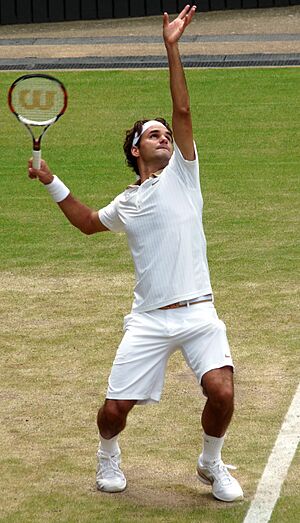

Gentlemen's Records Since 1877
| Record | Era | Player(s) | Count | Winning years |
|---|---|---|---|---|
| Most singles titles | Amateur Era | 7 | 1881–1886, 1889 | |
| Open Era | 8 | 2003–2007, 2009, 2012, 2017 | ||
| Most consecutive singles titles | Amateur Era | 6 | 1881–1886 | |
| Open Era | 5 | 1976–1980 2003–2007 |
||
| Most doubles titles | Amateur Era | 8 | 1897–1901, 1903–1905 | |
| Open Era | 9 | 1993–1997, 2000 (with Mark Woodforde), 2002–2004 (with Jonas Björkman) | ||
| Most consecutive doubles titles | Amateur Era | 5 | 1897–1901 | |
| Open Era | 1993–1997 | |||
| Most mixed doubles titles | Amateur Era | 4 | 1963, 1965–1966, 1968 (with Margaret Court) 1953–1956 (3 with Doris Hart, 1 with Shirley Fry Irvin) |
|
| Open Era | 4 | 1967, 1971, 1973–1974 (with Billie Jean King) 1999 (with Lisa Raymond), 2003 (with Martina Navratilova), 2010 (with Cara Black), 2015 (with Martina Hingis) |
||
| Most Championships (singles, doubles & mixed doubles) |
Amateur Era | 13 | 1897–1906 (5 singles, 8 doubles) | |
| Open Era | 10 | 1993–2004 (9 doubles, 1 mixed doubles) |
Ladies' Records Since 1884
| Record | Era | Player(s) | Count | Winning years |
|---|---|---|---|---|
| Most singles titles | Amateur Era | 8 | 1927–1930, 1932–1933, 1935, 1938 | |
| Open Era | 9 | 1978–1979, 1982–1987, 1990 | ||
| Most consecutive singles titles | Amateur Era | 5 | 1919–1923 | |
| Open Era | 6 | 1982–1987 | ||
| Most doubles titles | Amateur Era | 12 | 1914 (with Agatha Morton), 1919–1923, 1925 (with Suzanne Lenglen), 1926 (with Mary Browne), 1927, 1930 (with Helen Wills), 1933–1934 (with Simonne Mathieu) | |
| Open Era | 7 | 1976 (with Chris Evert), 1979 (with Billie Jean King), 1981–1984, 1986 (with Pam Shriver) | ||
| Most consecutive doubles titles | Amateur Era | 5 | 1919–1923 | |
| Open Era | 4 | 1981–1984
1991 (with Larisa Neiland), 1992–1994 (with Gigi Fernández) |
||
| Most mixed doubles titles | Amateur Era | 7 | 1919, 1921, 1923 (with Randolph Lycett), 1927 (with Frank Hunter), 1928 (with Patrick Spence), 1930 (with Jack Crawford), 1932 (with Enrique Maier) | |
| Open Era | 4 | 1985 (with Paul McNamee), 1993 (with Mark Woodforde), 1995 (with Jonathan Stark), 2003 (with Leander Paes) | ||
| Most Championships (singles, doubles & mixed doubles) |
Amateur Era | 19 | 1914–34 (12 doubles, 7 mixed doubles) | |
| Open Era | 20 | 1976–2003 (9 singles, 7 doubles, 4 mixed doubles) | ||
| Combined | 20 | 1961–79 (6 singles, 10 doubles, 4 mixed doubles) |
Other Interesting Records
| Record | M/W | Player(s) | Details | Year(s) |
|---|---|---|---|---|
| Unseeded champions | Men | Ranked 20th Ranked 125th |
1985 2001 |
|
| Women | Ranked 42nd | 2023 | ||
| Youngest singles champion | Men | 17 years 7 months | 1985 | |
| Women | 15 years 9 months | 1887 | ||
| Oldest singles champion | Men | 41 years 6 months | 1909 | |
| Women | 37 years 9 months | 1908 | ||
| Lowest-ranked winner | Men | 125th | 2001 | |
| Women | 42nd | 2023 | ||
| Singles winning % | Men | 92.72% (51–4) | 1973–1981 (Open era) | |
| Women | 90.36% (75–8) | 1984–1999 (Open era) | ||
| Singles match wins | Men | 105 | 2001–2021 (Open era) | |
| Women | 120 | 1973–2004 (Open era) | ||
| Most matches played | Men | 223 | 1922–39, 1948–64 | |
| Women | 326 | 1973–2006 | ||
| Most consecutive events played | Men | 30 | 1888–1922 | |
| Women | 26 | 1960–1985 | ||
| Longest match by time | Men | 11hrs 5mins | 2010 | |
| Women | 3hrs 45mins | 1995 | ||
| Longest final by time | Men | 4hrs 57mins | 2019 | |
| Women | 2hrs 45mins | 2005 | ||
| Winners of both junior and senior singles |
Men | 1972 1982 1983 1998 |
1976–80 inclusive 1987 1988, 1990 2003–07, 2009, 2012, 2017 |
|
| Women | 2011 1960 1956 1994 1996 |
2021 1962 1969 (under married name Jones) 1997 2006 |
Images for kids
See also
 In Spanish: Campeonato de Wimbledon para niños
In Spanish: Campeonato de Wimbledon para niños
- 2012 Summer Olympics venues
- List of British finalists at Grand Slam tennis tournaments
- Wimbledon (film)
- Wimbledon Effect
- Lists of champions
- List of Wimbledon champions (all events)
- List of Wimbledon singles finalists during the Open Era, records and statistics
- Other Grand Slam tournaments



